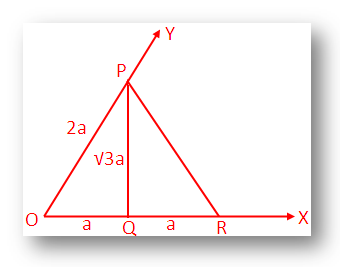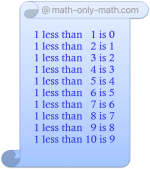Trigonometrical Ratios of 60°
How to find the Trigonometrical Ratios of 60°?
Let a rotating line →OX rotates about O in the anti-clockwise sense and starting from its initial position →OX traces out ∠XOY = 60° is shown in the above picture.
Take a point P on →OY and draw ¯PQ perpendicular to →OX.
Let a rotating line →OX rotates about O in the anti-clockwise sense and starting from its initial position →OX traces out ∠XOY = 60° is shown in the above picture.
Take a point P on →OY and draw ¯PQ perpendicular to →OX.
Now, take a point R on →OX such that ¯OQ = ¯QR and join ¯PR.
From △OPQ and △PQR we get,
¯OQ = ¯QR,
¯PQ common
and ∠PQO = ∠PQR (both are right angles)
Thus, the triangles are congruent.
Therefore, ∠PRO = ∠POQ = 60°
Therefore, ∠OPR
= 180° - ∠POQ - ∠PRO
= 180° - 60° - 60°
= 60°
Therefore, the △POR is equilateral triangle
Let, OP = OR = 2a;Thus, OQ = a.
Now, from pythagoras theorem we get,
OQ2 + PQ2 = OP2
⇒ a2 + PQ2 = (2a)2
⇒ PQ2 = 4a2 – a2
⇒ PQ2 = 3a2
Taking square roots on both the sides we get,
PQ = √3a (since, PQ > 0)
Therefore, from the right angled triangle POQ we get,
sin 60° = ¯PQ¯OP=√3a2a=√32;
cos 60° = ¯OQ¯OP=a2a=12
And tan 60° = ¯PQ¯OQ=√3aa=√3
Therefore, csc 60° = 1sin60°=2√3=2√33
sec 60° = 1cos60°= 2
And cot 60° = 1tan60°=1√3=√33
Trigonometrical Ratios of 60° are commonly called standard angles and the trigonometrical ratios of these angles are frequently used to solve particular angles.
● Trigonometric Functions
- Basic Trigonometric Ratios and Their Names
- Restrictions of Trigonometrical Ratios
- Reciprocal Relations of Trigonometric Ratios
- Quotient Relations of Trigonometric Ratios
- Limit of Trigonometric Ratios
- Trigonometrical Identity
- Problems on Trigonometric Identities
- Elimination of Trigonometric Ratios
- Eliminate Theta between the equations
- Problems on Eliminate Theta
- Trig Ratio Problems
- Proving Trigonometric Ratios
- Trig Ratios Proving Problems
- Verify Trigonometric Identities
- Trigonometrical Ratios of 0°
- Trigonometrical Ratios of 30°
- Trigonometrical Ratios of 45°
- Trigonometrical Ratios of 60°
- Trigonometrical Ratios of 90°
- Trigonometrical Ratios Table
- Problems on Trigonometric Ratio of Standard Angle
- Trigonometrical Ratios of Complementary Angles
- Rules of Trigonometric Signs
- Signs of Trigonometrical Ratios
- All Sin Tan Cos Rule
- Trigonometrical Ratios of (- θ)
- Trigonometrical Ratios of (90° + θ)
- Trigonometrical Ratios of (90° - θ)
- Trigonometrical Ratios of (180° + θ)
- Trigonometrical Ratios of (180° - θ)
- Trigonometrical Ratios of (270° + θ)
- Trigonometrical Ratios of (270° - θ)
- Trigonometrical Ratios of (360° + θ)
- Trigonometrical Ratios of (360° - θ)
- Trigonometrical Ratios of any Angle
- Trigonometrical Ratios of some Particular Angles
- Trigonometric Ratios of an Angle
- Trigonometric Functions of any Angles
- Problems on Trigonometric Ratios of an Angle
- Problems on Signs of Trigonometrical Ratios
11 and 12 Grade Math
From Trigonometrical Ratios of 60° to HOME PAGE
Didn't find what you were looking for? Or want to know more information about Math Only Math. Use this Google Search to find what you need.
Recent Articles
-
Word Problems on Multiplication and Division of Fractions | Worksheet
Apr 12, 25 03:45 AM
word problems on multiplication and division of fractions -
One More than Numbers upto 10 | Counting One More | Learn 1 more Than
Apr 11, 25 04:09 PM
1 more than means we need to add or count one more number to the given numbers. Here, we will learn counting one more than upto number 10. Examples of counting 1 more than up to number 10 are given as… -
One Less than Numbers upto 10 | Counting One Less | Learn 1 Less Than
Apr 11, 25 04:07 PM
What is one less than? 1 less than means we need to subtract or count one less number of the given numbers. Here, we will learn counting one less than upto number 10. Examples of counting 1 less than… -
Properties of Multiplication and Division of Fractions Worksheet | Ans
Apr 10, 25 03:17 PM
In properties of multiplication and division of fractions worksheet you will get different types of questions based on properties of multiplication of fractional numbers and properties of division of… -
Word Problems on Fraction | Math Fraction Word Problems |Fraction Math
Apr 09, 25 01:44 AM
In word problems on fraction we will solve different types of problems on multiplication of fractional numbers and division of fractional numbers.




New! Comments
Have your say about what you just read! Leave me a comment in the box below. Ask a Question or Answer a Question.